【最新】高中英语人教版必修四课件:Unit+4+Body+Language+语法专题课
合集下载
人教版高中英语必修四 Unit4 Body Language reading 课件

Para1 Body language is one of the most powerful means of communication, often even more powerful than spoken language. People around the world show all kinds of feelings, wishes and attitudes that they might never speak aloud. It is possible to "read" others around us, even if they do not intend for us to catch their unspoken communication. Of course, body language can be misread, but many gestures and actions are universal.
but many gestures and actions are universal. Para7 With so many cultural differences between people, it is great
to have some similarities in body language. We can often be wrong about each other, so it is an amazing thing that we understand each other as well as we do!
Para7 With so many cultural differences between people, it is great to have some similarities in body language. We can often be wrong about each other, so it is an amazing thing that we understand each other as well as we do!
英语:必修4 Unit4 Body Language全单元课件(新人教版)
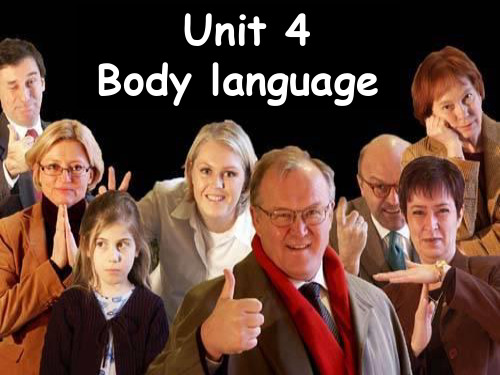
_P_a_r_t_2_(_p_a__r_a_2_3_4_5)People from different
countries express greetings in different ways.
_P_a_r_t_1_(_p_a__r_a_1)Meet the visitors at the airport
• It includes body movements, facial expressions, gestures, posture , speaking distance and other non-verbal signals.
Game: Choose a student to the front of the blackboard and bring out the meaning of some words by some postures.
Charlie Chaplin.
2. Do the actors say anything in the show?
No, nothing.
3. How do they express themselves?
By what they do and their facial expressions.
4. What do you call that?
_P_a_r_t_3_(_p_a__r_a_6) the reason why body languages
are different
Second reading
Part 1
meet
1 . Who will be present at the meeting?
businessmen from foreign countries
countries express greetings in different ways.
_P_a_r_t_1_(_p_a__r_a_1)Meet the visitors at the airport
• It includes body movements, facial expressions, gestures, posture , speaking distance and other non-verbal signals.
Game: Choose a student to the front of the blackboard and bring out the meaning of some words by some postures.
Charlie Chaplin.
2. Do the actors say anything in the show?
No, nothing.
3. How do they express themselves?
By what they do and their facial expressions.
4. What do you call that?
_P_a_r_t_3_(_p_a__r_a_6) the reason why body languages
are different
Second reading
Part 1
meet
1 . Who will be present at the meeting?
businessmen from foreign countries
人教版高中英语必修四Unit 4《Body language》ppt课件4

Section Ⅳ Writing
思路点拨 素材积累 实战成篇
肖刚是2016年里约奥运会上的一名志愿者,在服务中得知不同国 家的身势语在不同的国家有着不同的含义。现就在服务中所了解 的有关这方面的知识写信告诉好友李华。信件要包括以下内容:
1.不同文化有不同的身势语; 2.法国人热情,见到熟人互相握手,亲吻彼此的脸; 3.一般来说,世界上大部分国家的人见面都握手,但日本人更喜欢 鞠躬; 4.不同的身势语无所谓好与坏,但了解它们可以增进了解,减少误 解,避免交往中的困难。 注意: 1.使用书信的格式; 2.不要逐字逐句地翻译要点,可根据需要适当增加。
As we all know,every culture has its own body language.Take greetings for example.The French are open-minded.They shake hands and kiss each other on each cheek when they meet people they know.In general,people from most countries in the world now greet each other by shaking hands,but the Japanese prefer to bow.
思路点拨 素材积累 实战成篇
一般信件开头常用的句式: ①Glad to write to you! ②I beg to take this opportunity to inform you that... ③I’m very much delighted to inform you that... ④I would share... with you. 介绍body language 时常用的句型: ①As we all know,every culture has its own body language. ②Shaking hands is used by most countries. ③Take...for example. ④None of the actions is good or bad. ⑤Learning the customs of different cultures can avoid
思路点拨 素材积累 实战成篇
肖刚是2016年里约奥运会上的一名志愿者,在服务中得知不同国 家的身势语在不同的国家有着不同的含义。现就在服务中所了解 的有关这方面的知识写信告诉好友李华。信件要包括以下内容:
1.不同文化有不同的身势语; 2.法国人热情,见到熟人互相握手,亲吻彼此的脸; 3.一般来说,世界上大部分国家的人见面都握手,但日本人更喜欢 鞠躬; 4.不同的身势语无所谓好与坏,但了解它们可以增进了解,减少误 解,避免交往中的困难。 注意: 1.使用书信的格式; 2.不要逐字逐句地翻译要点,可根据需要适当增加。
As we all know,every culture has its own body language.Take greetings for example.The French are open-minded.They shake hands and kiss each other on each cheek when they meet people they know.In general,people from most countries in the world now greet each other by shaking hands,but the Japanese prefer to bow.
思路点拨 素材积累 实战成篇
一般信件开头常用的句式: ①Glad to write to you! ②I beg to take this opportunity to inform you that... ③I’m very much delighted to inform you that... ④I would share... with you. 介绍body language 时常用的句型: ①As we all know,every culture has its own body language. ②Shaking hands is used by most countries. ③Take...for example. ④None of the actions is good or bad. ⑤Learning the customs of different cultures can avoid
英语:必修4 Unit4 Body Language全单元课件(新人教版).
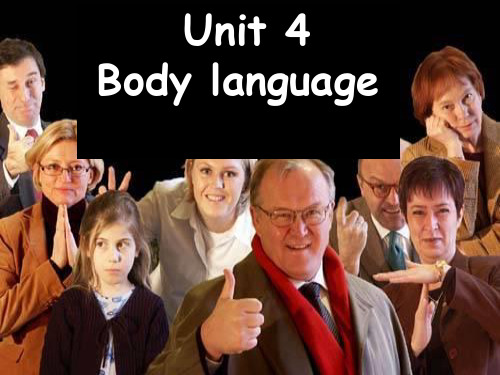
What are they trying to tell us? How are they expressing themselves?
Come and join us!
You’re great! Байду номын сангаас’m listening carefully!
I’m sorry!
Nice to meet you!
First reading :
After your listening, decide how many parts the passage can be divided into, and find out the main idea of each part.
Part 2(para2345)People from different _______________
2.I ate too much.
3.I am sorry I did Hanging head. something wrong. 4. I’m so happy. Smiling, arms open and head back.
angry
Threaten sb.
Happy, feel at ease, hide your feeling
I’m thinking!
Give me a little time!
OK!
I give up.
It’s important.
Let’s enjoy a short film
What is he eating? Does he enjoy it?
1. Who is the funny man in the film?
Frown and turn your back to someone Close your hand and shake it at someone.
人教版高中英语必修四第四单元《Body language》ppt课件
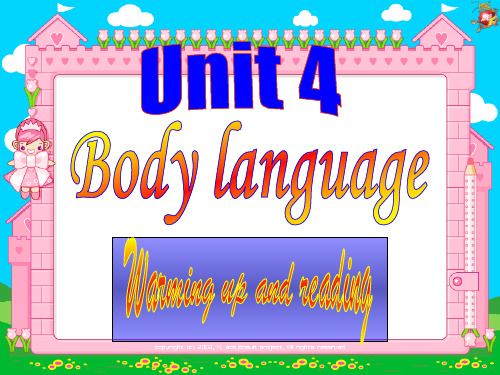
She _s_te_p_p_e_d__b_a_c_k___ appearing _s_u_r_p_r_is_e_d_ and put up her hands, as if in _d__e_f_e__n_c__e__.
The second
cultural
Akira Nagata from
(Japan)
Para2: Find out the two cultural mistakes the
author found at the airport:
Tony Garcia
from
The
(Columbia
fstake
Julia Smith from
(Britain)
He approached Julia , _to_u_c_h_e_d_ _h_e_r___ _s_h_o_u_l_d_e_r_ and _k_is_s_e_d__ her on the _c_h_e_e_k___.
mistake
George Cook from (Canada)
He _b__o_w_e_d__ to Mr. Cook and his nose __to_u_c_h_e_d__ George’s _m__o_v_in_g_ __h_a_n_d___.
He _r_e_a_c_h_e_d_ __h_is_____ __h_a_n_d__ __o_u_t____ to the Japanese.
Scanning
Scan the text and answer the following questions.
How many international students are there in the story?
The second
cultural
Akira Nagata from
(Japan)
Para2: Find out the two cultural mistakes the
author found at the airport:
Tony Garcia
from
The
(Columbia
fstake
Julia Smith from
(Britain)
He approached Julia , _to_u_c_h_e_d_ _h_e_r___ _s_h_o_u_l_d_e_r_ and _k_is_s_e_d__ her on the _c_h_e_e_k___.
mistake
George Cook from (Canada)
He _b__o_w_e_d__ to Mr. Cook and his nose __to_u_c_h_e_d__ George’s _m__o_v_in_g_ __h_a_n_d___.
He _r_e_a_c_h_e_d_ __h_is_____ __h_a_n_d__ __o_u_t____ to the Japanese.
Scanning
Scan the text and answer the following questions.
How many international students are there in the story?
高中英语必修4 Unit_4_Body_language课件

Mr.ada
Japan Jordan
Ahmed Aziz
Madame Coulon
You
France
China
Listening:
Which is the main idea of the text? A. There are different customs in different countries. B. Foreigners should follow the customs of the country where they are visiting. C. People use body movements to send messages and different body movements have different meanings. D. The importance of knowing customs.
diplomacy situations
daily life & business
Different ways to meet or part
handshake
a loving hug a kiss on the cheek
two palms together
nose- kiss
bowing
does not stand very close to others or touch strangers
Visitor (Japan)
George Cook (Canada)
Julia Smith (Britain)
• She is deaf and dump, so body language plays a very important part in her life.
Japan Jordan
Ahmed Aziz
Madame Coulon
You
France
China
Listening:
Which is the main idea of the text? A. There are different customs in different countries. B. Foreigners should follow the customs of the country where they are visiting. C. People use body movements to send messages and different body movements have different meanings. D. The importance of knowing customs.
diplomacy situations
daily life & business
Different ways to meet or part
handshake
a loving hug a kiss on the cheek
two palms together
nose- kiss
bowing
does not stand very close to others or touch strangers
Visitor (Japan)
George Cook (Canada)
Julia Smith (Britain)
• She is deaf and dump, so body language plays a very important part in her life.
人教版高中英语必修四Unit 4《Body language》ppt公开课课件
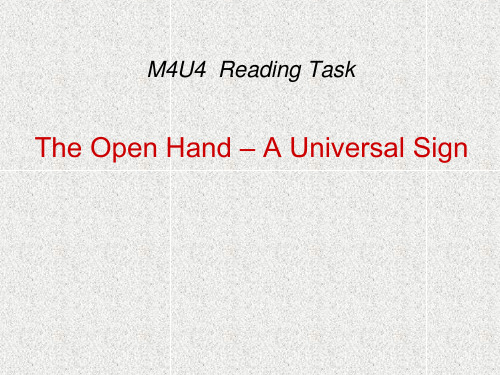
Based on the logical meaning, decide the order of the 4 questions in a paragraph. Para1: The most popular way to show the open hand in the world
* Why do people smile? * How do people shake hands? * Smile and handshake – the two most popular ways of greeting * Why do people shake hands?
* Chinese * Japanese * Hindu * Muslim * Young people in the West
Carried meaning – the same
Think about it!
What can we do to avoid misunderstanding caused by ways of greeting between people from different cultures?
Order?
Para1: The most popular way to show the open hand in the world
1.Smile and handshake – the two most popular ways of greeting 2. Why do people smile? 3. Why do people shake hands? 4. How do people shake hands?
Para2:
* Chinese * Japanese * Hindu * Muslim * Young people in the West
高中英语人教版必修4Unit 4 Body language 课件PPT

13. truly adv.真实地;真诚地;真正地→ true adj.真实 的→ truth n. 真实;真理
14. curious adj.好奇的→ curiously adv. 好奇地→ curiosity n.好奇心
15. defend vt. 保护;保卫→ defence n.防御;保卫
1.语境串记(用所给词的适当形式填空) (1)It was curious that he should have given in to c_u_r_i_o_s_it_y
单项填空
(5)Last week,Susan and David, __B__ our university's
student association, met the Chinese guests at the New
York airport.
A. to represent
B. representing
用represent的适当形式完成下列句子。 ① He was picked out from the whole class
to _r_e_p_r_e_se_n_t_ them at the other school. ② This painting is a r_e_p_r_e_s_e_n_ta_t_i_o_n_ of a
Unit 4 Body language
Ⅰ. 高 频 单 词 必 记 1._r_e_p_r_e_se_n_t___ vt. 2._a_p__p_ro_a_c_h__ vt. & vi. n. 3._m__a_j_o_r adj. 4._a_d_u_l_t_ n.
adj. 5._l_ik_e_l_y_ adj.
通知;通告;布告
14. curious adj.好奇的→ curiously adv. 好奇地→ curiosity n.好奇心
15. defend vt. 保护;保卫→ defence n.防御;保卫
1.语境串记(用所给词的适当形式填空) (1)It was curious that he should have given in to c_u_r_i_o_s_it_y
单项填空
(5)Last week,Susan and David, __B__ our university's
student association, met the Chinese guests at the New
York airport.
A. to represent
B. representing
用represent的适当形式完成下列句子。 ① He was picked out from the whole class
to _r_e_p_r_e_se_n_t_ them at the other school. ② This painting is a r_e_p_r_e_s_e_n_ta_t_i_o_n_ of a
Unit 4 Body language
Ⅰ. 高 频 单 词 必 记 1._r_e_p_r_e_se_n_t___ vt. 2._a_p__p_ro_a_c_h__ vt. & vi. n. 3._m__a_j_o_r adj. 4._a_d_u_l_t_ n.
adj. 5._l_ik_e_l_y_ adj.
通知;通告;布告
人教版高中英语必修四课件-Unit 4 Body Language P-1PPT课件

Person & country
Suitable greeting
a man from Canada To M: Shakes hands.
To F: Shakes hands or kisses on
Both cheeks if known.
a woman from France To M: Shakes hands or kisses
• 2. What parts of the world are not represented by the visitors?
Africa, Australia and Central America.
• 3. Why is Julia Smith surprised?
Julia Smith is surprised that Mr Garcia touches her shoulder and kisses on the cheek when they meet.
They shake hands & kiss each other twice on each cheek.
• 6. Is the main character male or female?
How do you know?
From the 5th paragraph we know that there are only two women, one is Julia Smith, the other is Madame Coulon, so the main character must be a man.
7 I’m very nervous. 8 I’m tired &sleepy.
Patting or rubbing stomach. Hanging head. Smiling, arms open and head back.
【高中课件】人教版高中英语必修四Unit 4Body language课件.ppt

One of your classmates came in this morning looking very upset about something, but you cannot imagine what it is. So you want to write to him/her a short message to ask about what is wrong and whether you can help.
I do the action and you speak out the meaning of the action.
Well-done
OK
quiet
stop
Do you know the meaning of the following body movements ?
I’m very excited.
Feelings
Body language
Happiness Anger or unhappiness
▲smiling ▲__f_r_o_w_n_i_n_g_ and turning
one’s back to someone ▲making a __f_is_t__ and
shaking it
__A_g_r_e_e_m__en__t __ ▲nodding the head up
Showing our feelings
Task 1: Skimming
Which is the main idea of the passage?
A.Only gestures without spoken language may cause misunderstanding.
B.Some body language or gestures are the same throught the world.
人教版高中英语必修四Unit 4《Body language》ppt公开课课件
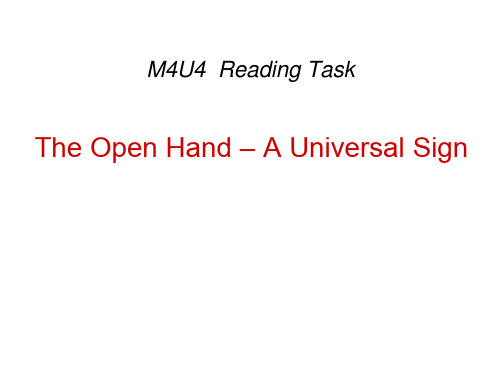
2. Why do people smile? 3. Why do people shake hands? 4. How do people shake hands?
பைடு நூலகம்
Para1: stranger: someone we don’t know unfamiliar place: place we haven’t been to or
Carried meaning – the same
Think about it!
What can we do to avoid misunderstanding caused by ways of greeting between people from different cultures?
1. Be friendly and understanding.
Body language – different Carried meaning – the same
Structure of Para2:
Body language – different
* Chinese * Japanese * Hindu * Muslim * Young people in the West
2. Always wear a smile when greeting, for its something universal.
3. Combine spoken language and unspoken language to communicate better.
4. Learn more about cultural difference and make adjustment whenever necessary.
பைடு நூலகம்
Para1: stranger: someone we don’t know unfamiliar place: place we haven’t been to or
Carried meaning – the same
Think about it!
What can we do to avoid misunderstanding caused by ways of greeting between people from different cultures?
1. Be friendly and understanding.
Body language – different Carried meaning – the same
Structure of Para2:
Body language – different
* Chinese * Japanese * Hindu * Muslim * Young people in the West
2. Always wear a smile when greeting, for its something universal.
3. Combine spoken language and unspoken language to communicate better.
4. Learn more about cultural difference and make adjustment whenever necessary.
高中英语Unit-4-Body-language课件-新课标-人教版-必修4

.Body language is very general, and
not all members of all cultures behave in the same way.
• She is deaf and dumb, so body language plays a very important part in her life.
gesture
eye contact
posture facial expression
What is body language?
Body language is the movements(动作) or positions (状态) of our body that show other people what we are thinking or feeling. Such as eye contact, facial expression, gesture, and posture.
Bows
Akira Nagata (Japan)
shakes hands
George Cook (Canada)
Darlene Coulon (France)
approaches others closely and touches their shoulder and kisses them on the cheek
D. The importance of knowing customs.
Please divide the passage into four parts and find out the main idea of each part.
Part 1 : (Para1)
A) Summary of body language.
not all members of all cultures behave in the same way.
• She is deaf and dumb, so body language plays a very important part in her life.
gesture
eye contact
posture facial expression
What is body language?
Body language is the movements(动作) or positions (状态) of our body that show other people what we are thinking or feeling. Such as eye contact, facial expression, gesture, and posture.
Bows
Akira Nagata (Japan)
shakes hands
George Cook (Canada)
Darlene Coulon (France)
approaches others closely and touches their shoulder and kisses them on the cheek
D. The importance of knowing customs.
Please divide the passage into four parts and find out the main idea of each part.
Part 1 : (Para1)
A) Summary of body language.
【最新】高中英语人教版必修4课件:Unit+4+Body+language

each other, but people from Englishspeaking countries do not touch each other.If you touch an English person,you should say “Sorry”.People in Arab countries like standing close to one another when they are talking,but English people must keep
Different countries have different body language.For example ,men in Russia, France and Arab countries kiss each other when they meet ,but men in China or Australia shake hands instead of kissing.People in Puerto Rico like touching
1.distance n. 2.movement n. 3.communicate v. 4.pleasant adj. 5.comfortable adj.
距离;远方 运动 交流 令人愉快的 舒服的;舒适的
1.Why is body language important? ________________________________________________________________ 2.What do men usually do when they meet in Russia? ________________________________________________________________ 3.Where mustn't you touch the head of another person? ________________________________________________________________
高中英语人教版必修4课件:Unit4Body language
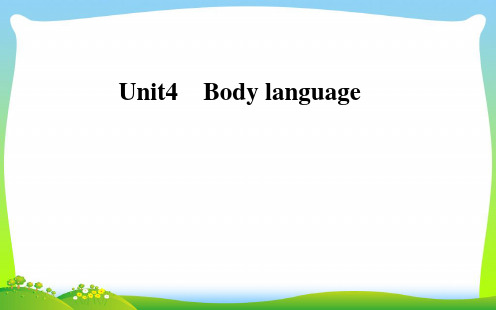
答 案 : ①about ②with/in ③With/In ④have been curious about ⑤It's curious that ⑥out of curiosity
3.approach vt. & vi.接近;靠近;走近
n.[U]接近
[C]方法;途径;通路 (教材原句 P26)Tony approached Julia,touched her shoulder and kissed her on the cheek! 托尼走近朱莉娅,摸了摸她的肩,并亲了她的脸!
represent vt. (1)代表;象征;表示 ①The performers represented our community to give amusing performances. 这些演员代表我们的社区,做了精彩有趣的表演。 ②A dove represents peace. 鸽子象征着和平。 ③The colour red commonly represents danger. 红色通常表示危险。
归纳拓展 (1)be curious about 对……感到好奇 be curious to do 极想做…… It is curious that...……是奇怪的。(从句的谓语通常 用 should do 或 should have done 的形式,译为“竟然”)
(2)in/with curiosity 好奇地
归纳拓展 in association with 与……联合/合作 have (no) association with 与……(没)有联系
⑦I benefited much from my association with him. 我从跟他的交往中获益匪浅。 ⑧ The book was published in association with People's Education Press. 这本书是与人民教育出版社联合出版的。 ⑨The rise of the production has association with the use of natural fertilizers. 产量的上升与天然肥料的使用有关系。
- 1、下载文档前请自行甄别文档内容的完整性,平台不提供额外的编辑、内容补充、找答案等附加服务。
- 2、"仅部分预览"的文档,不可在线预览部分如存在完整性等问题,可反馈申请退款(可完整预览的文档不适用该条件!)。
- 3、如文档侵犯您的权益,请联系客服反馈,我们会尽快为您处理(人工客服工作时间:9:00-18:30)。
Body language
语法专题
教学目标
I. Know the rules of the –ing form. 1. The –ing form can be used as an attribute. 2.The –ing form can be used as an adverbial of time/reason/accompanying/result… II. Make use of the rules to make sentences.
• 7.When Darlene Coulon from France came dashing through the door, she recognized Tony smiling face. Garcia’s_________ • 8.In the same way that people communicate with spoken language, they also express their feelings using unspoken ‘language’ through physical ___________________________________________ ______________________. distance,actions and posture
Task 1
呈现新知
1.Yesterday, another student and I, representing our university’s student association _______________________________________ , went to the Capital International Airport to meet this year’s international students. 2.I saw several young people enter the waiting area, looking around curiously ____________________________. watching them 3.I stood for a minute_____________________ and then went to greet them. appearing surprised 4.She stepped back _________________. 5.Then Akira Nagata from Japan came in ___________. smiling 6.Just at the moment, however, Akira bowed so his nose touched ____________________. George’s moving hand
Task 2
感受新知
Fill in the blanks
Task 3the places of the words or phrases in green!
1.On the bed lies a sleeping baby. 2.There is a baby sleeping in the bed. 3.Looking about ,he saw nothing around him. 4.Tom stood there, not moving, and waited for the approaching bus. 5.You speak English very well, considering you have only been studying for a year.
1.He is a post mandelivering ________letters from door to door. 2.While the professor was doing the experiment, the boy sat there observing ________carefully.. defending honor of his nation.. 3.He lost his life _________the enjoying the beautiful sights outside. 4.She sat by the windows,__________ shaking 5.The ________buildings showed us that an earthquake was coming. 6.How attentive the students are! They are all sitting focusing their eyes on the screen. straight,________ approaching athletes reach the other end of 7. It is exciting to watch_________ the swimming pool. 8.The blind man walked touching _______ the walls of the building .
指点迷津 归纳总结
现在分词可以在句中作定语和状语
修饰名词的现在分词 (如:1.6.7 in Task1 ),在句中作定 语
修饰名词的现在分词 (如:2.3.4.5.8 in Task1 ),在句中作状 语
【尝试运用】 observe deliver focus touch approach enjoy defend shake
指点迷津 指点迷津
现在分词作定语在句中位置
单个的现在分词放在 它所修饰词前面
现在分词词组放在它 所修饰词的后面
II. Translate
Hearing the news 1. __________________ (听到这个好消息), we were all excited. knowing his address 2.Not ______________________ (不知道他的地址), we couldn’t get in touch with him. talking with another teacher (同另一个 3. The teacher stood there, ________________________ 老师谈话). 4. ______________________( 往右转), you will find the post office . Turning to the right 5. I turned off the light,________________________( 所以什么也看 seeing nothing 不见). what he said 尽管相信他的话), we still think that he 6.Admitting ___________________( hasn’t tried his best. shopping 购物) together. 7. After a discussion, our family went _________( Judging from her appearance (从她的外表看), she seems to 8. ___________________________ be a doctor.
语法专题
教学目标
I. Know the rules of the –ing form. 1. The –ing form can be used as an attribute. 2.The –ing form can be used as an adverbial of time/reason/accompanying/result… II. Make use of the rules to make sentences.
• 7.When Darlene Coulon from France came dashing through the door, she recognized Tony smiling face. Garcia’s_________ • 8.In the same way that people communicate with spoken language, they also express their feelings using unspoken ‘language’ through physical ___________________________________________ ______________________. distance,actions and posture
Task 1
呈现新知
1.Yesterday, another student and I, representing our university’s student association _______________________________________ , went to the Capital International Airport to meet this year’s international students. 2.I saw several young people enter the waiting area, looking around curiously ____________________________. watching them 3.I stood for a minute_____________________ and then went to greet them. appearing surprised 4.She stepped back _________________. 5.Then Akira Nagata from Japan came in ___________. smiling 6.Just at the moment, however, Akira bowed so his nose touched ____________________. George’s moving hand
Task 2
感受新知
Fill in the blanks
Task 3the places of the words or phrases in green!
1.On the bed lies a sleeping baby. 2.There is a baby sleeping in the bed. 3.Looking about ,he saw nothing around him. 4.Tom stood there, not moving, and waited for the approaching bus. 5.You speak English very well, considering you have only been studying for a year.
1.He is a post mandelivering ________letters from door to door. 2.While the professor was doing the experiment, the boy sat there observing ________carefully.. defending honor of his nation.. 3.He lost his life _________the enjoying the beautiful sights outside. 4.She sat by the windows,__________ shaking 5.The ________buildings showed us that an earthquake was coming. 6.How attentive the students are! They are all sitting focusing their eyes on the screen. straight,________ approaching athletes reach the other end of 7. It is exciting to watch_________ the swimming pool. 8.The blind man walked touching _______ the walls of the building .
指点迷津 归纳总结
现在分词可以在句中作定语和状语
修饰名词的现在分词 (如:1.6.7 in Task1 ),在句中作定 语
修饰名词的现在分词 (如:2.3.4.5.8 in Task1 ),在句中作状 语
【尝试运用】 observe deliver focus touch approach enjoy defend shake
指点迷津 指点迷津
现在分词作定语在句中位置
单个的现在分词放在 它所修饰词前面
现在分词词组放在它 所修饰词的后面
II. Translate
Hearing the news 1. __________________ (听到这个好消息), we were all excited. knowing his address 2.Not ______________________ (不知道他的地址), we couldn’t get in touch with him. talking with another teacher (同另一个 3. The teacher stood there, ________________________ 老师谈话). 4. ______________________( 往右转), you will find the post office . Turning to the right 5. I turned off the light,________________________( 所以什么也看 seeing nothing 不见). what he said 尽管相信他的话), we still think that he 6.Admitting ___________________( hasn’t tried his best. shopping 购物) together. 7. After a discussion, our family went _________( Judging from her appearance (从她的外表看), she seems to 8. ___________________________ be a doctor.
